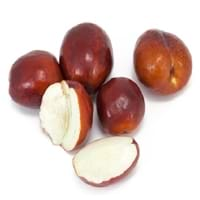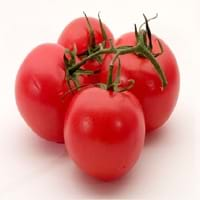Health Benefits
Cancer prevention, Diarrhea treatment, Improves muscular strength, Liver health, Maintains hormonal balance, Reduces nervous tension, Reduces blood circulation problems, Reduces stress, Regulation of heart rate, Treatment of hysteria
Anti depressant, Cancer prevention, Heart care, Muscle pain relief, Prevents constipation, Regulation of heart rate, Weight loss properties
General Benefits
Anti oxidant properties, Digestive aid, Flu treatment, Helps in weight loss, Strengthens bones, Treatment of common cold
Controls blood pressure, Eye care, Maintains healthy cholesterol level, Strengthens bones
Skin Benefits
Heals sunburn, Hydrates skin, Reduces wrinkles, Skin rejuvenation, Skin revitalization
Anti-aging benefits, Heals sunburn, Skin rejuvenation, Treatment of acne, Treatment of skin diseases
Hair Benefits
Promotes longer and healthier hair, Protects hair
Good conditioner, Prevents hair loss, Softening mask
Allergy Symptoms
Abdominal pains, Breathing difficulty, Diarrhea, Hives, Itching in eyes, Itching of nose, Nasal congestion, Redness of eyes, Runny nose, Sneezing, Wheezing
Anaphylaxis, Coughing, Diarrhea, Eczema, Hives, Itching sensation in throat, Nausea, Skin Rashes, Runny nose, Sneezing, Swelling of mouth, tongue or lips, Vomiting, Wheezing
Side Effects
Decrease in blood sugar levels, Intense headache
Heart burn
Lactating Women
Not Available
Yes
Best Time to Eat
As a snack in the late afternoon, Don't consume at night and before bed, Morning time (before lunch), Strictly avoid empty stomach
Along with meal, Don't consume at night and before bed, Morning time (before lunch)
Vitamin B5 (Pantothenic Acid)
Not Available
Vitamin B9 (Folic acid)
Not Available
Vitamin C (Ascorbic Acid)
Vitamin E (Tocopherole)
Not Available
Vitamin K (Phyllochinone)
Not Available
Lutein+Zeaxanthin
Not Available
Phytosterol
Not Available
Calories in Fresh Fruit with Peel
Calories in Fresh Fruit without Peel
Not Available
Not Available
Calories in Frozen Form
Not Available
Calories in Canned Form
Not Available
Calories in Juice
Not Available
Calories in Jam
Not Available
Calories in Pie
Not Available
Type
Tree fruit
Berry, Fruit vegetable
Season
Autumn, Summer
All seasons
Varieties
Honey Jar, Sugar Cane, Li, Shanxi Li, Sherwood, Chico, Silverhill, Tigertooth, Winter Delight and Lang
Better Boy, Early Girl, Beefsteak, Beefmaster, Pink Brandywinem, Caspian Pink, Thai Pinks, Hawaiian Pineapple, Kellogg’s Breakfast, Cherokee Purple, Black Ethiopian and Paul Robeson
Color
Green, Red, Yellow
Green, Orange, Pink, Purplish black, Red, White, Yellow
Origin
Syria
Central America, South America
Soil Type
Sandy, Well-drained
Loam, Sandy loam
Climatic Conditions
Warm to hot climate
Sunny, Warm
Facts about
- Pigment extracted from Indian jujube is used for silk dyeing in Burma.
- In Korea, jujube wood is used to make wind instrument taepyeongso.
- Fresh jujube is known as Chinese apple & dried form is called as Chinese date.
- Around 10,000 varieties of tomatoes are grown in the world.
- In Buñol, people celebrate the Tomatina festival where around 1.5 lakh tomatoes are used.
- As per Guinness book of records, heaviest tomato weighed 3.51 kg.
Other Countries
Bangladesh, India, Iran, Korea, Lebanon, Pakistan
Brazil, Egypt, India, Iran, Italy, Mexico, Spain, Turkey, United States of America
Top Importer
United States of America
Nigeria
Top Exporter
China
Netherlands
Botanical Name
Ziziphus zizyphus
Solanum lycopersicum
Synonym
Ziziphus jujuba or Ziziphus mauritania or Zizyphus jujuba
Lycopersicon esculentum
Subkingdom
Tracheobionta
Tracheobionta
Division
Magnoliophyta
Magnoliophyta
Class
Magnoliopsida
Magnoliopsida
Subclass
Rosidae
Asteridae
Family
Rhamnaceae
Solanaceae
Species
Z. zizyphus
S. lycopersicum
Generic Group
Not Available
Nightshade
Difference Between Jujube and Tomato
We might think that Jujube and Tomato are similar with respect to nutritional value and health benefits. But the nutrient content of both fruits is different. Jujube and Tomato Facts such as their taste, shape, color, and size are also distinct. The difference between Jujube and Tomato is explained here.
The amount of calories in 100 gm of fresh Jujube and Tomato with peel is 79.00 kcal and 18.00 kcal and the amount of calories without peel is Not Available and Not Available respectively. Thus, Jujube and Tomato belong to High Calorie Fruits and Low Calorie Fruits category.These fruits might or might not differ with respect to their scientific classification. The order of Jujube and Tomato is Rosales and Solanales respectively. Jujube belongs to Rhamnaceae family and Tomato belongs to Solanaceae family. Jujube belongs to Ziziphus genus of Z. zizyphus species and Tomato belongs to Solanum genus of S. lycopersicum species. Beings plants, both fruits belong to Plantae Kingdom.









